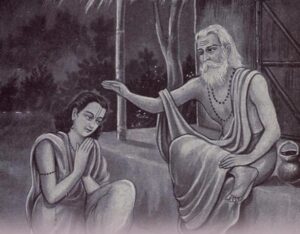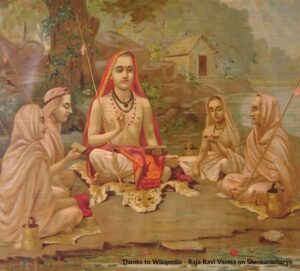Post By: Vishwanath Iyer Published on: December 25, 2016 Reading time: 3 minutes

Guru and student in the ancient Gurukul system
The Vedas are a large body of texts composed in Vedic Sanskrit originating in Bhārat (Indian Subcontinent). In fact, the Vedic texts are the oldest body of literature and scriptures emanating from this region. Also, Vedas have their root in the Sanskrit word vid which means without limit. Lastly, Vedas are the philosophical base on which yoga is built.
Within Bhārat, those that consider the Veda as scriptural authority of Hinduism are called आस्तिक (āstika – believers). Additionally, these followers recognise that the Vedas are अपौरुषेय (apauruṣeya – not of man), meaning that they were composed in a state of merger with the Supreme identity (Brahman).
Consequently, those that do not accept the authority of the Veda are called नास्तिक (nāsthika – non-acceptors of that the Veda-s are apauruṣeya). These are followers of Christianity, Islam, Jainism, Buddhism and any Hindu with similar views.
Importantly, Vedas are also called śruti (that which is heard), possibly because these were composed before 4000 BCE, well before the formulation of Sanskrit grammar, syntax and rules by Panini around 400 BCE when all transmission of knowledge was by ear and by rote.
 collection of hymns used in yajña or sacrifice.
collection of hymns used in yajña or sacrifice.Rig Veda is the oldest of all extant vedic text. Also, it is a collection of 1028 stanzas and 10600 verses organised into 10 mandalas or books/ chapters. Additionally, this Veda deals primarily with the origins of the universe, various deities and ancient rituals and practices.
Yajur Veda was composed much later than Rig Veda and has around 1875 shokas or verses. Additionally, it contains detailed instructions for conducting yajña or sacrifice and is split into two major subgroups;
Sāma Veda consists of 1549 shokas or verses, almost all taken from Rig Veda. Additionally, Sāma Veda consists of;
Atharva Veda consists of 760 shlokās or hymns out of which 160 are common with the Rig Veda. Composed primarily by Āngiras and Atharvān, it is a later Veda, composed between 900 BC and 1000 BC. Importantly, it deals with rites, rituals and practices of the period, mainly marriage and cremation.
Introduction to vedas presented in a simple way so that common man can understand.
It is amazing to know that vedic times is much earlier to origin of other religions. If the communication was as good as present sanatana dharma would have been followed all over the world.
Very sorry for the delayed response, it got lost in the clutter,
Thank you for your feedback. We are continuously updating the site and would be grateful for any input that can make yoga relevant to modern day living,